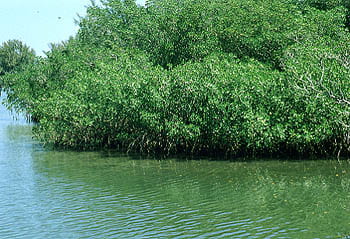
Red Mangrove
Mangals are assemblages of woody plants known as mangroves, often several species dominate different zones with respect to distance from a marine shore. This is a red mangrove, Rhizophora mangle, on a protected Atlantic coast of Florida, near Fort Pierce. Mangroves are well adapted to the anoxic sediments into which the roots extend.
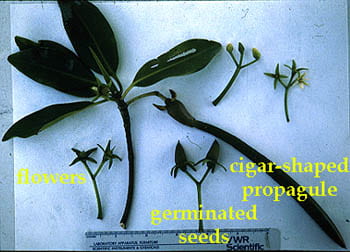
Mangrove Reproductive Structures. Photo by Robert Twilley
Mangals dominate the intertidal zone of the tropics. The mangrove trees have unique biological adaptations to survive this marine environment, including reproductive biology, salt tolerance, and growth form. Here the reproductive structures of the genus Rhizophora, is shown including flowers, fruits, and the distinctive propagule. The mangroves are unique in that the seed germinates while still attached to the tree. A cigar-shaped seedling may drop to the water to float away, or it may drop and stick directly in the mud and grow.
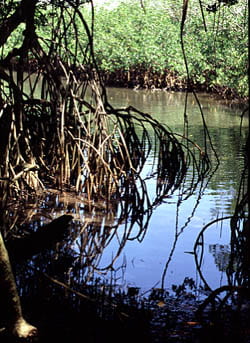
Aerial Roots
Above the water level, mangroves are in many ways typical terrestrial shrubs, with trunks, stems, leaves, and flowers. Their root system, however, is adapted to the anoxic sediment, and all mangroves have root extensions that project into the air so that the underground parts of the plant can obtain oxygen. Mangroves may have prop roots, structures that extend midway from the trunk and arch downward, or they may have pneumatophores, upward extensions of the roots, into the air, which allow access to oxygen.
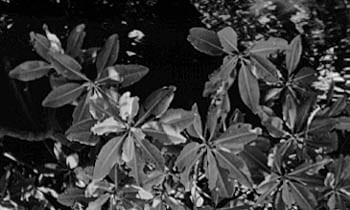
Leaves of Red Mangrove. Photo by H. Lessios
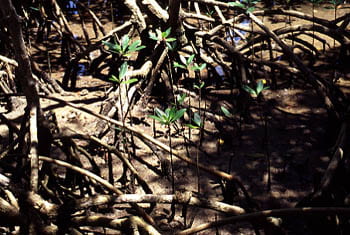
Seedlings and Prop Roots of Red Mangrove
Seedlings may be established by seeds that drop directly from the plant into the sediment below. Seeds may also float and disperse a great distance. Although the propagule varies in size among species of Rhizophora, all float in sea water for a time following detachment from the parent plant. Eventually the propagule will become vertically erect in the water and become rooted in a quiescent environment, as shown here near Fort Pierce, Florida.
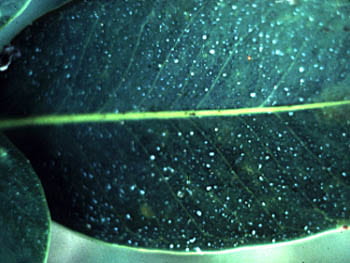
Adaptation to Salinity and Salt Excretion. Photo by Robert Twilley
Mangroves are halophytes, or salt-tolerant plants. They can tolerate more salt in their sap than terrestrial plants, although there is variation among mangrove species in the degree of tolerance. The most tolerant species have salt glands in their leaves, allowing for the secretion of salt, as shown here on the leaf of Avicennia germinans in southwest Florida during the dry season when soil salinity is greatest.
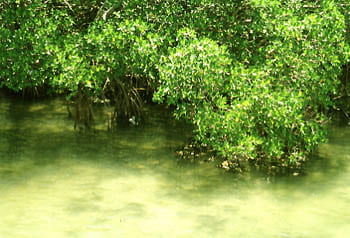
Coastal Mangrove and Muddy Waters
Fine sediment accumulates around mangals, making for very turbid water at high tide. The mud flats that accumulate are rich in particulate organic matter and benthic animals. In many coastal areas mangrove islands are distributed throughout shallow bays and lagoons and are frequently used as bird rookeries because they provide protection and isolation from predators. The birds deposit guano that helps provide nutrients for the trees.
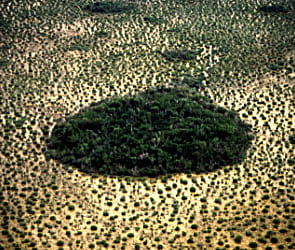
Mangrove Hammocks. Photo by Robert Twilley
Mangrove islands also occur along inland coastal areas of land as shown here in the Everglades National Park in south Florida. These mangrove islands are known as hammocks and form tear shape patterns parallel to the flow of water and to the coast.
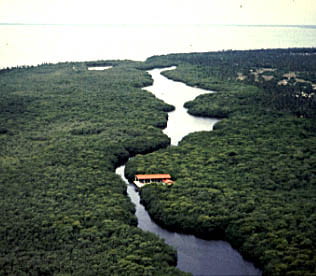
Tidal Creek. Photo by Robert Twilley
Mangroves colonize the intertidal zone of tropical tidal creeks, as shown here along Estero Pargo in Terminos Lagoon, Mexico. Fringe mangroves border the tidal creek while more inland are found basin mangrove forests.

Basin Mangroves, Puerto Rico. Photo by Robert Twilley
Inland of fringe forests that border tidal creeks are basin mangroves. In the neotropics these forests are either mixed species of Rhizophora, Avicennia, and Labuncularia, while farther inland in zones of higher salinity, forests may consist of monospecific stands of Avicennia, as shown here in Puerto Rico. Note the forest floor is covered by the pencil shaped specialized root structures known as pneumatophores, which help in the exchange of oxygen with subterranean roots.
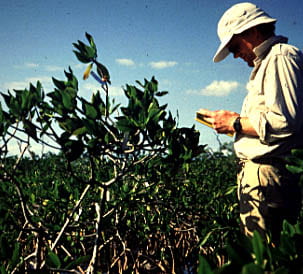
Dwarf Mangroves. Photo by Robert Twilley
Dwarf mangroves are mature forests that are limited in growth by soil conditions that may include low nutrients, high salinity, or excessive sulfide concentrations. the dwarf forest here is found along the coral reef of Belize and is estimated to be about 40 y old. Tree growth here is limited by lack of nutrients in the peaty soil.
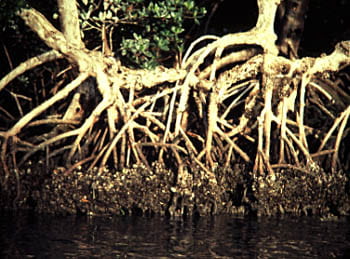
Oysters on Prop Roots. Photo by Robert Twilley
There are many diverse animal communities associated with mangrove habitats. Those faunal groups associated with prop roots and sediment are marine assemblages, while animals in the canopy are terrestrial. Here oysters colonize the prop roots of Rhizophora mangle in Rookery Bay, Florida.
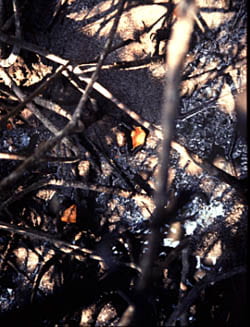
Crab Ucides occidentalis. Photo by Robert Twilley
Crabs are probably one of the most diverse and ecologically significant faunal groups in mangroves. They influence forest structure, zonation, litter dynamics, productivity and nutrient cycling. Here is a group of mangrove crabs, Ucides occidentalis, harvesting mangrove leaves that have fallen to the forest floor. These leave will be transported by the crabs down their burrows where they accumulate during the year. It is not sure what nutritional value this source of organic matter has for the crabs, but it does influence the fate of mangrove leaf litter in the forest.
Question: Can you find another environment where crabs benefit plant growth?
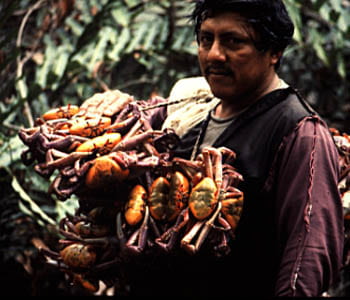
Crabs to Market. Photo by Robert Twilley
These crabs, along with many other marine organisms that find refuge in mangrove habitats, are commercially important to local human populations that harvest them for food and revenue. Here an Ecuadorian carries a morning’s harvest of Ucides occidentalis from a mangrove forest along the Churute River estuary for sale in the city of Guayaquil.
